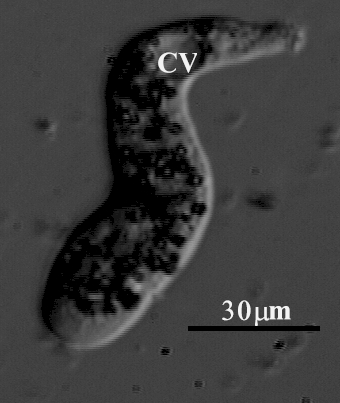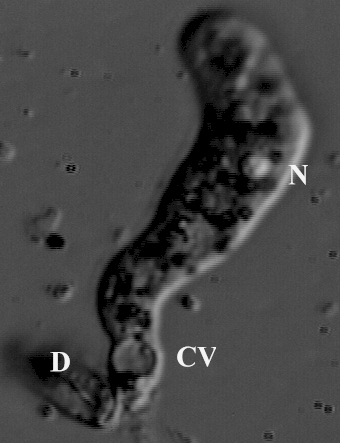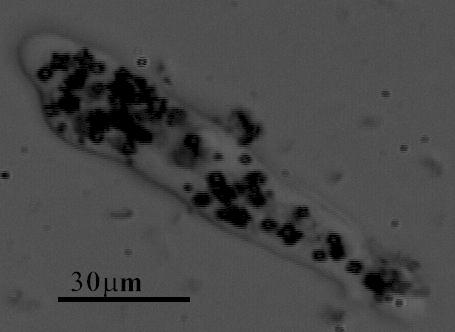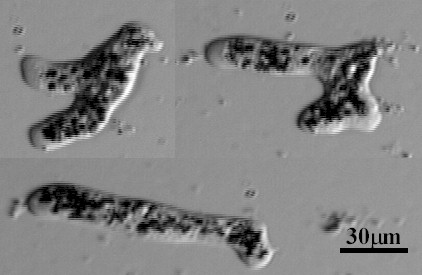|
Saccamoeba |
|
Updated
11/8/02 |
 |
 |
 |
|
Figure 1.
Left Saccamoeba locomoting towards bottom of page. Middle Saccamoeba
showing contractile vacuole (CV) distending the uroid, and the nucleus
(N). A diatom is adhering to the uroid. Right, Bright field image of
a Saccamoeba showing cytoplasmic square crystals. |
|
Very similar in
appearance to Trichamoeba, except that the nucleolus is
single and central. The glycocalyx too is similar to Trichamoeba
although Page (Page,
1988) has pointed out the similarity of the
cup shaped structures of Saccamoeba to those of members of the
family Hartmannellidae. So far only one marine Saccamoeba
has been isolated (Anderson et al
1997), although earlier evidence for a marine
Saccamoeba had been discussed (see p23, Page
1983). Locomotion is by steady expansion at
the leading edge rather than the eruptive expansions of the Vahlkampfiidae.
Golgi present as typical stacks. Some species have cytoplasmic
bacteria. The uroid is much as Trichamoeba, sometimes (not
the species in Figure 1) large bulbous
with adherant filaments. But some do not have an obvious uroid (e.g. S.
limax; and the putative Saccamoeba in Figure 1). Saccamoeba
do not have a floating form (if it does its probably a Trichamoeba).
Saccamoeba are usually mono-nucleate. It is noted that Saccamoeba
is sometimes polypodal (Page, 1976),
especially when changing direction as in Figure 2. The placement of Saccamoeba within the
Family Hartmannellidae and the very similar Trichamoeba in the
Family Amoebidae seems incongruous. However, recent data suggests an
affinity between Saccamoeba and Hartmannella
(Amaral Zettler et al, 2000). It may be better to disband the
Family Hartmannellidae since the genus Hartmannella seems related
most closely to Acanthamoeba at least by some SSUrDNA but not all
(Amaral Zettler et al, 2000)
analysis. More sequences from other genera of amoeba will have to be
determined to sort out these relationships, and more than this single Saccamoeba
(S.limax ATCC 30942)
species to ensure that Saccamoeba is actually monophyletic. Distension of the uroid by the contractile vacuole (see
Figure 1, middle) is typical of Saccamoeba but not exclusive to the
genus. Many Saccamoeba produce cysts. The Saccamoeba featured in Figure 1 could not be
identified to species but was obtained from a large freshwater pond in the
Penicuik estate, Midlothian, S.E. Scotland. Note the many square and
plate shaped crystals. |
 |
Figure 2.
Saccamoeba showing temporary bi-podal locomotive morphology as it
changes direction. The pseudopods advanced smoothly without sudden
eruption as in Vahlkampfia. |
 Saccamoeba
at the Protist Information Server Saccamoeba
at the Protist Information Server
|
| Saccamoeba angelica
(Bovee,
1972). There is some doubt about this species
status as a Saccamoeba (Page, 1988),
as it does not have the typical villous uroid. 50-100mm |
| Saccamoeba limax
35-85mm in
length. No cysts. Visible hyaline cap with an oval nucleus of 8mm. |
| Saccamoeba limna
(Bovee,
1972) Up
to 120mm
in length |
| Saccamoeba lucens (Bovee,
1972). 70-100mm
in length. |
| Saccamoeba marina
(Anderson et al, 1997)
32-102mm in length. The first
"certain" marine Saccamoeba, S. marina was
isolate from snady surface sediment off the coast of Scotland in the Forth
of Clyde. No observed cysts. |
| Saccamoeba stagnicola
30-75mm in
length. No cytoplasmic crystals. Cysts circular to oval at 15mm
in diameter. Has a spherical nucleus 6.5mm dia. |
| Saccamoeba wakulla
(Bovee,
1972) To 175mm in
length. Oval nucleus 3.5-6.5mm. no cysts.
Locomotes with a steady flattened pseudopod with a distinct hyaline layer. |
|
| Strains
available:- |
| ATCC 30942 Saccamoeba
limax (F-13) Griffin, J.L. Lincoln Woods State Park Providence RI.
1962 . SSUrDNA
AF293xxx, |
| ATCC 30943 Saccamoeba
sp. (F-71) Griffin, J.L. Riveway Pond, Boston, MA |
| ATCC 30944 Saccamoeba
limax (F-150) Griffin, J.L. Potomac River, Washington, DC. 1975 |
| CCAP 1534/6 Saccamoeba
limax Page, F.C. Lake Tuskegee, AL. 1966 |
| CCAP 1572/3 Saccamoeba
limax Page, F.C. Loch Morar, Scotland. 1977 |
| CCAP 1572/1 Saccamoeba
stagnicola Page, F.C. Coe Fen, Cambridge England 1972 |
| CCAP 1572/2 Saccamoeba
stagnicola Page, F.C. Pond, Harlton, Cambridge England 1972 |
|
References:-
Amaral Zettler,
L.A., Nerad, T.A., O'Kelly, C.J., Peglar, M.T., Gillevet, P.M., Silberman,
J.D. & Sogin, M.L. (2000). A molecular reassessment of the
Leptomyxid amoebae. Protist 151, 275-282.
Anderson, O.R.,
Rogerson, A. & Hannah, F.
(1997). Three new limax amoebae isolated from marine surface
sediments: Vahlkampfia caledonica N. Sp., Saccamoeba marina
N. Sp., and Hartmannella vacuolata N.Sp. J.Euk.Microbiol.
44(1), 33-42.
Bovee, E.C. (1972).
The lobose amoebas IV.
A key to the order granulopodida Bovee & Jahn, 1966, and descriptions
of some new and little-known species in this order. Arch.Protistenk.
114: 371-403.
Grebecki, A. (1987).
Locomotion of Saccamoeba
limax. Arch.Protistenk. 134: 347-365.
Page, F.C.
(1976). An illustrated key to freshwater and soil amoebae. Ambleside, Freshwater Biology Association.
Page, F.C. (1983) "Marine gymnamoebae".
Inst.Terr.Ecol. NERC.
Rohr, U., Weber, S., Michel, R., Selenka,
F. & Wilhelm, M. (1998) Comparison of free-living amoebae in hot water
systems of hospitals with isolates from moist sanitary areas by
identifying genera and determining temperature tolerance. App.Environ.Microbiol.
64, 1822-1824.
|
|
